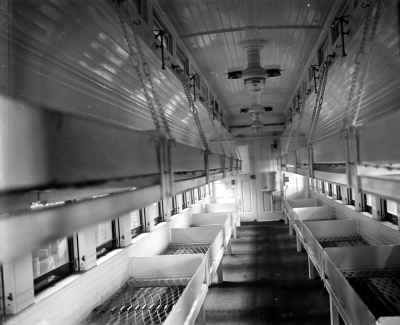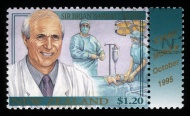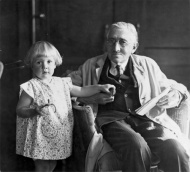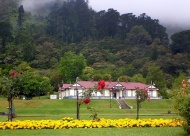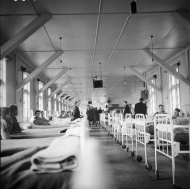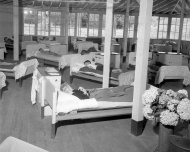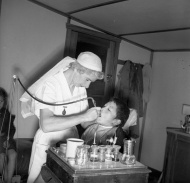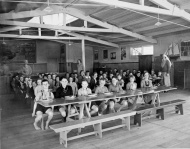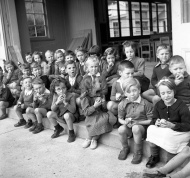Events In History
-
 19 November 1992Fred Hollows Foundation launched in NZ
19 November 1992Fred Hollows Foundation launched in NZThe foundation was established in Australia by the Kiwi-born ophthalmologist (eye doctor) to treat eye problems in poorer countries. Within six years 200,000 people had their sight restored through cataract surgery. Read more...
-
 5 August 1988Cartwright Report condemns cervical cancer treatment
5 August 1988Cartwright Report condemns cervical cancer treatmentThe report was triggered by Sandra Coney and Phillida Bunkle's Metro article, 'An Unfortunate Experiment'. Published in June 1987, this claimed that dozens of cervical cancer patients at National Women's Hospital were receiving inadequate treatment. Read more...
-
 10 February 1967End of free school milk
10 February 1967End of free school milkThe school milk scheme was begun in 1937 as part of the first Labour government's strategy to improve child health. Read more...
-
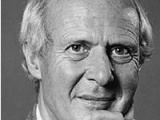 3 September 1958First open-heart surgery in NZ
3 September 1958First open-heart surgery in NZPioneering heart surgeon Brian Barratt-Boyes performed the surgery using a heart-lung bypass machine. The procedure, at Green Lane Hospital in Auckland, was performed on an 11-year-old girl with a hole in her heart. Read more...
Articles
School of Radiant Living

The School of Radiant Living was a movement active in New Zealand from the late 1930s until the late 1980s. Founder Dr Herbert Sutcliffe taught a holistic philosophy of physical, psychological and spiritual health.
-
Page 2 – Herbert Sutcliffe
Biography of the founder of the School of Radiant Living in New Zealand
-
Page 3 – Teachings
The teachings of Radiant Living were complex and involved holistic psychological, physical and spiritual health.
-
Page 4 – Peloha
'On yonder hill you will pitch your tent' prophesied the daughter of Golden Dawn founder Robert Felkin to Herbert Sutcliffe, as she pointed towards Te Mata Peak.
-
Page 5 – The Havelock work
Havelock North has long been a centre of 'alternative thought' or liberal theology in New Zealand.
-
Page 6 – Origins of Radiant Living
Radiant Living emerged from the American-based philosophical movement New Thought, which gained popularity in the late 19th century
-
Page 7 – Edmund Hillary
One of the first New Zealand schools of Radiant Living was established in Auckland. Its secretary was Gertrude Hillary who reported progress early in 1939. Her son, Edmund, was
-
Page 8 – The eliminating diet
To obtain physical fitness, it is of vital importance that the right mental attitude should accompany the food diet to enable the emotions, nerves and glands to co-operate
-
Page 9 – Salad recipes
Colour, beauty, exquisite artistry find joyous expression in the Art of Salad Making. The homemaker who serves salads so deliciously and artistically tempting that the
-
Page 10 – Further information
This web feature was written by Hilary Stace and produced by the NZHistory.net.nz team. Links
The 1918 influenza pandemic

The lethal influenza pandemic that struck New Zealand between October and December 1918 killed more than 8600 people in two months. No other event has claimed so many New Zealand lives in such a short time.
-
Page 2 – The pandemic begins abroad
The 1918 influenza pandemic was commonly referred to as ‘the Spanish flu’ but it did not originate in Spain.
-
Page 3 – The pandemic hits New Zealand
Many people believed that the second wave of the 1918 influenza pandemic arrived in New Zealand in the form of ‘a deadly new virus’ on board the RMS Niagara.
-
Page 4 – Uneven rates of death
No other event has killed so many New Zealanders in so short a space of time. While the First World War claimed the lives of more than 18,000 New Zealand soldiers over a four-
-
Page 5 – Response to the influenza pandemic
There were consistencies in New Zealand's response to the influenza pandemic. Many of these arose out of a circular telegram the Health Minister, George Russell, issued to all
-
Page 6 – Aftermath
Robert Makgill Following the pandemic speculation continued over the Niagara's involvement in bringing the virus to New Zealand.
-
Page 8 – South Island influenza death rates
Death rates in South Island towns and counties from the influenza pandemic
-
Page 10 – Further information
This web feature was written by Imelda Bargas and produced by the NZHistory.net.nz team.
Assisted immigration, 1947-75

New Zealand is a country of immigrants. Wave after wave of peoples have settled here: Polynesian, British, European, Asian.
- Page 2 - Peopling New ZealandThe Labour Department was responsible for setting up and administering the assisted immigration
Children and adolescents, 1930-1960

The need for the New Zealand government to promote national interests during the Depression and the Second World War created a renewed appreciation of the role of the family within society.
- Page 2 - Children's health By the late 1940s all New Zealand children had a medical examination on entering school, and were seen by a nurse at standards two and six. These examinations helped identify
Pacific Islanders in the NZEF

Cook Islanders, Niueans, Fijians and Gilbert Islanders all took their place in the ranks of the New Zealand Expeditionary Force during the First World War. As well as the dangers of war, Pacific soldiers faced language difficulties, an unfamiliar army diet and European diseases.
- Page 2 - Niueans and Cook IslandersInformation about Niuean and Cook Island soldiers who were part of the 3rd Maori Contingent of Reinforcements in
Homosexual law reform

The homosexual law reform campaign moved beyond the gay community to wider issues of human rights and discrimination. Extreme viewpoints ensured a lengthy and passionate debate before the Homosexual Law Reform Act was passed 27 years ago, in July 1986.
- Page 4 - Reforming the lawTo bring about change in the law, the gay movement needed a parliamentary champion. It found one in Member of Parliament Fran
Schools and the First World War

Schools and children were quickly called into action at the outset of the First World War in 1914. Developing patriotic, fit and healthy citizens was seen as important to the survival of the country and the Empire. Hundreds of teachers joined the NZEF, including many from sole-teacher schools. Almost 200 never returned.
- Page 2 - Schools in 1914The head of the Department of Education believed that ‘moral purpose should dominate the spirit of the whole school life.’ Schools and teachers were to shape children into
Merchant marine

On 3 September New Zealand honours Merchant Navy Day. Here we explore the little-known but vital role played by the merchant marine during the First World War, when these civilian seafarers often found themselves in the front line of the war at sea.
- Page 4 - Hospital shipsIn May 1915, as casualties mounted at Gallipoli, the government chartered a hospital ship, the Union Company's 5282-ton trans-Tasman liner
The Gallipoli campaign

Each year on Anzac Day, New Zealanders (and Australians) mark the anniversary of the Gallipoli landings of 25 April 1915. On that day, thousands of young men, far from their homes, stormed the beaches on the Gallipoli Peninsula in what is now Turkey.
- Page 7 - Soldiers' experienceLife for the New Zealand soldier on Gallipoli was tough. They struggled with the harsh environment, living and fighting amongst the deep ravines and high cliffs that towered above
Passchendaele: fighting for Belgium

Ever since 1917 Passchendaele has been a byword for the horror of the First World War. The assault on this tiny Belgian village cost the lives of thousands of New Zealand soldiers. But its impact reached far beyond the battlefield, leaving deep scars on many New Zealand communities and families.
- Page 7 - Helping the woundedMore than 14,000 New Zealanders were wounded between June and December 1917 in Belgium, and medical staff, orderlies, chaplains and stretcher-bearers worked round the clock to
Pacific aftermath

Participation in the First World War changed Pacific Islanders' lives. Returning servicemen had seen the world.
- Page 5 - Economic, social and political impactThe First World War opened the Pacific Islands to the world more than they ever had been
Hospital ships

The Maheno and Marama were the poster ships of New Zealand's First World War effort. Until 1915 these steamers had carried passengers on the Tasman route. But as casualties mounted at Gallipoli, the government - helped by a massive public fundraising campaign - converted them into state-of-the-art floating hospitals.
-
Page 6 – Later service and legacies
The Marama missed Gallipoli, reaching the Mediterranean a few weeks after the Allies abandoned the peninsula. The ships’ service pattern would now be dominated by long voyages
Biographies
-
 Buck, Peter Henry
Buck, Peter Henry
Biography of doctor, politician and anthropologist Peter Buck (Te Rangi Hīroa)
Read more... -
 Barratt-Boyes, Brian
Barratt-Boyes, Brian
At Green Lane Hospital Barratt-Boyes pioneered new surgical techniques involving the replacement of defective heart valves.
Read more... -
 Makgill, Robert Haldane
Makgill, Robert Haldane
Robert Makgill was a key figure in the development of New Zealand's public health system. He was one of the country's first district health officers and played a crucial role during the devastating 1918 influenza pandemic.
Read more... -
 Cruickshank, Margaret Barnet
Cruickshank, Margaret Barnet
Margaret Cruickshank was the first woman to be registered as a doctor in New Zealand. She worked tirelessly during the 1918 influenza pandemic but eventually caught the disease herself and died on 28 November 1918.
Read more... -
 Begg, Charles Mackie
Begg, Charles Mackie
Charles Begg was New Zealand's most decorated member of the Medical Corps during the First World War. He played a major role in the treatment of troops during the 1915 Gallipoli campaign.
Read more... -
 Jolly, Douglas Waddell
Jolly, Douglas Waddell
Dr Doug Jolly pioneered mobile emergency surgery during the Spanish Civil War. He is described by US medical historian David Adamas as ‘one of the most notable war surgeons of the 20th century’.
Read more... -
 Rout, Ettie Annie
Rout, Ettie Annie
Ettie Rout gained an infamous public profile as a safe-sex campaigner during the First World War.
Read more... -
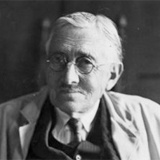 King, Frederic Truby
King, Frederic Truby
Dr Frederic Truby King provided the impetus for The Society for the Promotion of the Health of Women and Children, commonly known as the Plunket Society.
Read more...
Related keywords
- railways
- WW1 home front
- red cross
- ettie rout
- WW1
- brian barratt-boyes
- famous firsts
- stamps
- 1950s
- truby king
- plunket
- child welfare
- hospital ships
- maheno (hospital ship)
- doctors
- nurses
- women
- marama
- racism
- lord liverpool
- te aroha
- tourism
- historic places
- influenza pandemic
- epidemic
- battle of the somme
- casualties
- prisoners of war
- aboriginals
- merchant marine
- gallipoli campaign
- alternative lifestyle
- food
- exercise
- western front
- children
- education
- primary schools
- havelock north
- milk
- 1960s
- drink
- recipes
- economy
- cook islands
- niue
- pacific islanders
- maui pomare
- disease
- rarotongan company
- narrow neck camp
- pioneer battalion
- spanish civil war
- douglas jolly
- public service
- robert makgill
- Maori MPs
- peter buck
- ngati mutunga
- maori health
- physical education
- margaret cruickshank
- waimate
- universities
- charles begg
- WW1 stories
- pacific war
- malaria
- shipping
- trenches
- passchendaele offensive
- immigration
- assisted immigration
- immigrants
- new zealand house
- domestic staff
- housing
- british
- WW2
- battle for crete
- field ambulance
- edmund hillary
- postcard
- death
- upper hutt
- american forces
- public holidays
- whanganui city
- empire day
- war objects
- german army
- adolescents
- social policy
- armistice
- william trethewey
- takapuna
- otaki
- wellington city
- protest
- crime
- gay rights
- law reform
- homosexuals
- fran wilde
- norman jones
- labour party
- human rights
- seacliff
- anzac cove
- samoa
- robert logan
- disasters
- venereal disease
- anna stout
- anzac
- uniforms
- weapons
-
Main image: Red Cross railway carriage, 1915
An interior view of a railway carriage specially fitted out as a hospital car, 1915.

